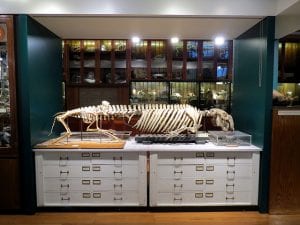Question of the Week: Why does the Kingfisher look blue?
By Cerys R Jones, on 25 September 2018
The Common Kingfisher is one of Britain’s most colourful native birds and a personal favourite of mine. Despite the name, the Common Kingfisher isn’t actually all that common. I’ve only been lucky enough to see one in the wild and it was a brief encounter; I still vividly remember the bright blue flash of its feathers. Although these creatures are known for their striking colours, the blue feathers down the back of the Kingfisher are actually brown.
The bright blue colour you perceive is due to a phenomenon called structural colouration. Structural colouration is seen throughout the animal kingdom and makes creatures appear much more colourful than they actually are. So while the coloured pigments in the kingfisher’s feathers are brown, you actually view them as a brilliant blue.

The brightly coloured Common Kingfisher (Image: Avijan saha)
Structural colouration, first described by Robert Hooke and Isaac Newton, is when the observed colour of an object is not due to the pigment but rather caused by some interference effects instead. The structure of the object itself causes a different colour to be perceived than what would typically be observed by the pigment. Structural colouration can result in iridescent colours – i.e. colours that are dependent on the viewing angle – or non-iridescent colours, when the colour remains constant regardless of the viewing angle. Examples of iridescent colours are the feathers of a peacock, which are also pigmented brown but appear blue due to the structural colouration, and the setea (or spines) of the sea mouse. The nanostructures of the setea of the sea mouse and peacock feathers are regular and so reflect the light in the same direction. This means that the bright colour is only perceived at a certain angle.
The setea of the sea mouse appear red, green and blue to act as a warning to potential predators. The sea mice in the Grant Museum are some of my favourite specimens in the museum and are often unfortunately overlooked by visitors. Their interesting name likely derives from the fact that they look like drowned mice when washed up on shore, but their Latin name, Aphrodita, comes from the Ancient Greek goddess of love, Aphrodite, supposedly due to their resemblance to female anatomy…
In contrast, the kingfisher’s feathers are an example of non-iridescent structural colouration. The blue stripe appears blue regardless of the angle of the viewer. This is because the structures are randomly oriented and so the reflections of the light are not angled in the same direction. The blue-and-yellow macaw similarly displays bright blue feathers that are due to non-iridescent structural coloration. These feathers also contain the brown-black pigment melanin that is present in those of the kingfisher.
Let that be a lesson that you can never trust your eyes – at least, not when it comes to structural colouration! Next time you visit the Grant Museum, look out for our kingfisher taxidermy specimen, the sea mice and any other brightly coloured creatures that may be cleverly appearing more colourful than their pigments might suggest!
To read more about this phenomenon, check out this paper.
 Close
Close





